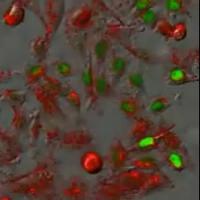
Watching cells communicate: CMO cells in "listening " (red) and "sending " (green) modes, as photographed in Dr. Sprinzak's laboratory. Cell communication is essential for the development of any organism. Scientists know that cells have the power to "talk" to one another, sending signals through their membranes in order to "discuss" what kind of cell they will ultimately become — whether a neuron or a hair, bone, or muscle. And because cells continuously multiply, it's easy to imagine a cacophony of communication.
But according to Dr. David Sprinzak, a new faculty recruit of Tel Aviv University's Department of Biochemistry and Molecular Biology at the George S. Wise Faculty of Life Sciences, cells know when to transmit signals — and they know when it's time to shut up and let other cells do the talking. In collaboration with a team of researchers at the California Institute of Technology, Dr. Sprinzak has discovered the mechanism that allows cells to switch from sender to receiver mode or vice versa, inhibiting their own signals while allowing them to receive information from other cells — controlling their development like a well-run business meeting.
Dr. Sprinzak's breakthrough can lead to the development of cancer drugs that specifically target these transactions as needed, further inhibiting or encouraging the flow of information between cells and potentially stopping the uncontrollable proliferation of cancer cells. Dr. Sprinzak's research appeared in the journal PLoS Computational Biology.
Over and out
A cell's communications behavior is mediated by the "Notch signalling pathway," one of the major communication channels between neighboring cells. Information is transferred between cells when Notch receptors from one cell come into contact with Delta molecules, or signals, from another cell. But when the same Delta molecules interact with Notch receptors in the same cell, Dr. Sprinzak found, they shut down their activity and prevent reception of signals from the outside world.
The researchers set out to learn how. In the lab, Dr. Sprinzak and his team attached fluorescent proteins to both Notches and Deltas to track the flow of information. What they found was that the Notch receptors and the Delta signals are actually capable of binding to each other, effectively shutting down each other's activity and forcing the cells into either sender or receiver modes.
"In one state, a cell can send a message and not receive, and in the other it receives and cannot send. They can talk or listen, but they cannot do both at the same time," says Dr. Sprinzak. He compares this communications system to a walkie talkie, in which only one user may be "on the air" at a time.
This switch is crucial to helping the cells make yes-and-no decisions in which neighboring cells adopt distinct fates. Such "cell fate" decisions are responsible for formation of boundaries between developmental tissues, such as those between the vertebrae protecting our spine. They can also account for many patterns of differentiation in the body, such as the pattern of neurons in our brain, or sensory hairs in the inner ear.
Far from enigmatic, this process can actually be seen in the lab. By measuring the fluorescence in real time, it is possible to watch how the levels of a cell's own Delta activity affect the ability of a cell to transfer messages to its neighbors.
Understanding biology through mathematical models
Sender and receiver behavior, says Dr. Sprinzak, not only determines how cells differentiate normally, but also how they differentiate in abnormal situations, such as when cancer cells are growing.
Source : American Friends of Tel Aviv University
 Print Article
Print Article Mail to a Friend
Mail to a Friend
